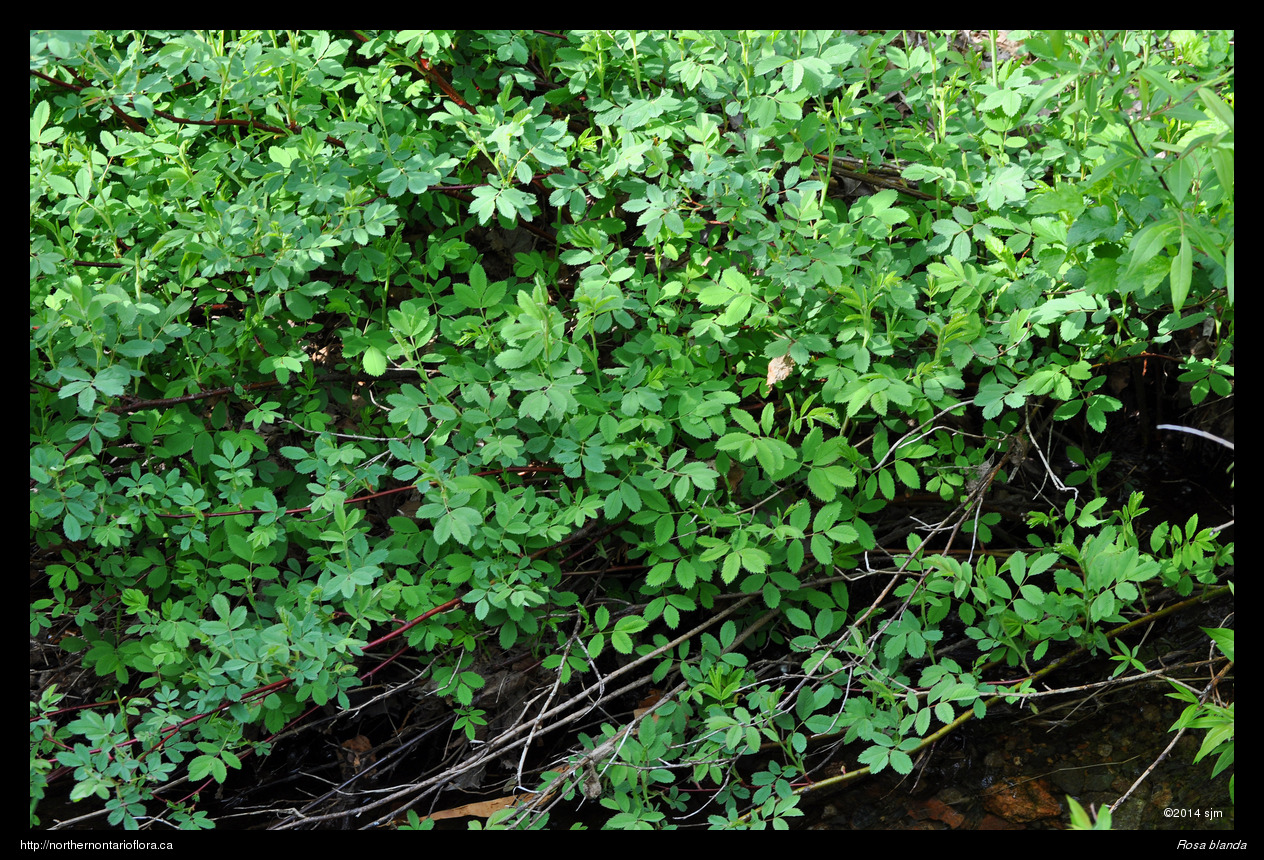
|
Northern Ontario Plant Database 
Plant DescriptionRosa blanda Aiton 1789, non Pursh 1814En: smooth wild rose, meadow rose
Rosaceae (Rose Family) General: A low, deciduous shrub, to 1.5 m tall, with showy pink flowers. Stems/twigs: Young stems are reddish-purple, smooth (glabrous), and sometimes have a waxy bloom (glaucous). Stems are generally unarmed or rarely bear a few scattered, straight prickles along the internodes. Older stems may be armed with a few straight prickles, while vigorous shoots are often prickly at the base. Buds are greenish to red and shiny, with a few imbricate scales. Leaf scars are very narrow and broad, with stipule scars extending as thin lines from either side of the leaf scar. Leaves: Alternate, pinnately compound, usually with 7 (sometimes 5 or 9) leaflets; a pair of conspicuous stipules is fused along the base of the petiole; stipules gradually widen towards the free end and terminate in small triangular tips; stipule margins are entire or glandular-ciliate. Petioles, stipules, and leaf rachis are finely hairy, and a few small prickles may be present on the underside of the leaf rachis. Leaflets are oval, elliptic, or obovate, 2—6 cm long, dull and glabrous above, paler and finely hairy beneath; blunt (obtuse) to pointed (acute) at the apex; rounded to tapering (cuneate) at the base; margins are toothed (serrate) to just below the middle. The terminal leaflet is short-stalked, while the lateral pairs of leaflets are sessile or very short-stalked. Flowers: Bisexual, solitary, or in small terminal or axillary clusters (cymes) of 2—3 flowers; each flower is 5—6 cm across. The base, or receptacle, of the flower forms a rounded cup-shaped hypanthium; the calyx lobes and petals are attached to the rim of the hypanthium. The flower stalks and hypanthium are glabrous and sometimes glaucous. The five calyx lobes are lanceolate with gradually tapering long narrow tips; the lower surface is glabrous or (usually) bears glandular hairs (stipitate glandular), while the upper surface is densely white-tomentose. The five petals are pink and broadly obovate to obcordate. Stamens and pistils are numerous; the numerous superior ovaries are contained within the hypanthium, but the short styles are densely clustered at the top of the hypanthium, forming a rounded 'brush' at the centre of the flower. Flowers bloom in early summer. Fruit: A fleshy glabrous hip, reddish, and usually globose or ovoid in shape. Each hip, 1—1.5 cm in diameter, contains numerous small achenes, 4.5—5 mm long. The calyx is persistent and erect in fruit (porrect), forming a 1—2 cm long beak at the end of the hip. Rose hips have a high Vitamin C content and may be used dried to make teas or fresh to make jellies. Fruits mature in late summer to early autumn. Habitat and Range: Moist to dry open woods, shrub thickets, clearings, and sandy or gravelly fields, shorelines, and roadsides; often growing over calcareous or basic bedrock or soil. The smooth rose is native to northeastern and central North America, with a range extending west from Nova Scotia to Saskatchewan and the southern North West Territories. Its range extends across Ontario and runs from southern Ontario north to James Bay, around 53° N (Soper and Heimburger 1982), and occurs throughout the Algoma District. Similar Species: Rosa palustris Marshall, the swamp rose, is found in shrubby marshes, swamps, and along stream and pond margins. Its stems bear pairs of stout, broad-based, curved prickles only at the nodes (infrastipular prickles); the fruit is a rounded orange-red hip that bears numerous stiff glandular hairs. Rosa acicularis Lindl., the prickly wild rose, is common in rocky or sandy shores and open woods. Its stems are armed along the internodes with numerous bristles and straight prickles; the fruit is a smooth, ovoid or pear-shape (pyriform), reddish-orange hip. Back to species list |
||||||||||||||||||||||






















